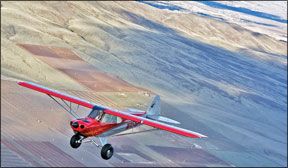As applied to airplanes, the word “performance” has a multi-tiered meaning. Wed guess most pilots think of speed first, then payload or climb and then maybe short or rough field capability. The light sport segment bollixes up the usual logic because none of them are very fast, although they vary in payload and runway capability. On that last point, a new LSA offering from CubCrafters promises to reset the scale on what short takeoff and landing capability means, so much so that there are going to be some envious Super Cub pilots in Alaska drooling over this thing. The airplane is called the Super SportCub and it was unveiled just prior to Sun n Fun. Had it not been for an item in the press announcement, we would have said that this airplane is simply another entry in what is turning out to be just way too many LSAs than the market will ever support. But that one thing was the engine: a 180-HP O-340 four-banger loosely based on Lycomings O-320, but stroked and modified as an experimental engine by Engine Components, Inc. But wait a minute… doesnt the airplane still have to meet the 1320-pound LSA gross weight limit and can it do that with that big engine? It does and, evidently, it can. 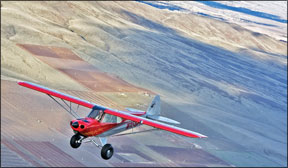
CubCrafters Jim Richmond told us at Sun n Fun that the Sport Cub is the best performing Cub hes built and hes been at it for three decades. CubCrafters produces a line of two-seat aircraft-from Super Cub rebuilds to kits to two LSAs-all based on the familiar Piper Cub legacy of a fabric-covered welded steel fuselage and metal-ribbed wings. All of the airplanes have strut-braced wings and bungee damped landing gear and all feature tandem seating.
The Super SportCub follows this design brief…to a point. The basic construction is there, with a welded tubular steel frame and fabric covering everything from the wings to the tail feathers to the control surfaces. But Super Cubs never had to meet the 1320-pound LSA weight limit so CubCrafters has obviously put the entire airplane on the harshest weight diet weve seen in quite some time.
Carbon fiber is evident everywhere, from the spinner, to the cowling, to interior panels and various bits and pieces that might have once been steel are now aluminum. “I ask my vendors if they know how many grams are in an ounce. If they say no, I tell them they need to know,” Richmond told us.
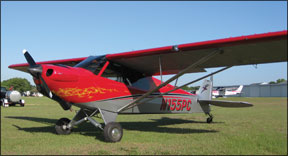
He showed us the brake rotors which were drilled motorcycle-style for cooling, but which also saves a few ounces. The brake calipers are magnesium rather than the heavier steel normally used in aircraft brakes where weight isn’t as much of a concern.
In our view, what makes this LSA unusual is the firewall forward treatment. The vast majority of LSAs use the Rotax 912 series engine because its inexpensive and its light, at about 125 pounds fully dressed compared to about 200 pounds for the lightest conventional air-cooled aircraft engines. In fact, with the exception of the Continental O-200, Continental and Lycoming don’t own a significant share of the LSA market. Lycomings LSA entry-the O-233-isn’t expected to be available until 2010.
CubCrafters unlikely entry in the conventional engine arena is the OX-340 Stroker, a kit engine from ECI. Its loosely based on Lycomings O-320, but stroked to increase the displacement to 340 cubic inches at an 8.8-to-1 compression ratio. Thats all good stuff, but the engine would still be too heavy were it not for other mods that CubCrafters makes.
Richmond told us the company has removed about 41 pounds from the engine, none of it from the basic power delivery train, with the exception of a lighter prop flange. (The version we flew had a metal prop, but the production airplane will have a composite prop.)
As is usually the case, weight reduction comes from everywhere. For example, the sump in the Lycoming/ ECI version is cast, but CubCrafters makes its own of sheet metal, saving 10.8 pounds. Further, the cylinders have tapered cooling fins, saving a few more ounces and there’s a light, compact oil cooler mounted on top of the engine, where the fuel injection spider would normally go. (Although the Stroker is
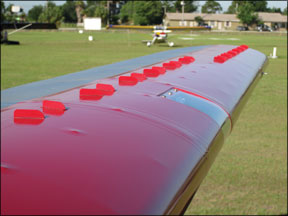
available with fuel injection, the CubCrafters variant is carbureted.)
Look closely in the photos and you’ll see a couple of subtle scoops atop the cowling, looking like the sort of decorative thing Detroit used in the 1960s. But theyre real enough and direct air down into the oil cooler from the top. The cowling is made of carbon fiber strategically bonded with fiberglass for corrosion protection of adjoining aluminum surfaces.
Richmond said CubCrafters hasnt done detailed climb cooling tests yet, but in our brief flight trial on a warmish Florida morning, we didnt see cylinder head temps above the low 300s and EGTs were consistently in the high 1200s or low 1300s. The O-340s accessory case is also simplified and lightened.
There’s really nothing on it: no vacuum pump and no mags, saving the component and mounting weight. The engine uses the Light Speed experimental ignition system, which lives in a couple of boxes on the cold side of the firewall. The Cub has Light Speeds System 3, which has map-based variable timing with up to 38 degrees of advance, depending on sensed RPM and manifold pressure.
For redundancy, it relies on ships electrical power. In the event of alternator failure, the procedure is to shut down one system and fly the airplane on the other. In that case, says Richmond, the battery will run the ignition until the fuel runs out. (The airplane carries 25 gallons in two wing-mounted tanks equipped with sight gauges in the wing roots.) This isn’t a certified engine, but it comes from experimental antecedents. Where does it live, regulatorily speaking? Its a bit of an outrider: a pure ASTM engine.
CubCrafters doesnt buy the engine complete, but buys the components from ECI (and others) and has a third party, Premier Aircraft Engines in Troutdale, Oregon, assemble the engine. Cub That required a lot of ASTM paper shuffling. “There are 500 parts in that engine; I can tell you how every one of them meets the ASTM requirement,” Richmond says. As far as we know, CubCrafters is the first LSA manufacturer to take on its own engine. What the payoff? Power, mainly. The Cub Stroker engine is rated at 180-HP for takeoff and for five minutes, then 80-HP continuous. But thats a limitation set entirely by CubCrafters, not ECI or anyone else.
As for TBO, Richmond told us it hasnt been established yet but for now, it will be set by the fleet leader engine, which has only 100 hours. ECI is about to conduct a
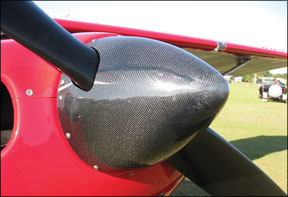
240- to 350-hour test cell run towards eventually establishing a 2400-hour TBO.
So a stock Vero Beach Super Cub has 150 HP and some have been converted to 180-HP O-360s, so whats the big deal with the Super-Sport Cub? The big deal is that it weighs about 200 pounds less and although that doesnt impact cruise much, it provides a quantum leap in takeoff and climb performance. And leap isn’t much of an exaggeration.
During our brief flight trial at South Lakeland Airport during Sun n Fun, Jim Richmonds takeoff roll might have been 50 feet, but it felt like less. Initial climb rates of 2000 feet are possible and Richmond told us on his flight east from Washington State, the airplane was still capable of 1000 feet a minute above 10,000 feet when crossing high terrain.
Even with that much horsepower in a light airframe, we didnt notice any untoward P-factor effects. The standard stab on the right rudder seemed adequate. There’s not much un-Cublike in the airplanes handling, which is what youd expect. Trim is entirely electric, via a rocker on the end of the stick.
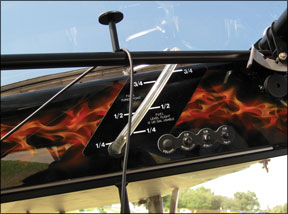
Call us dinosaurs, but we think electric-only trim in anything, much less a traditional taildragger, diminishes the fly-by-feel experience. So does looking at an EFIS airspeed tape. Speaking of which, the SuperSport Cub is capable of flying brain-dead slow. In his slow flight demo, Richmond slowed the airplane to the low 30s (MPH) before it gave up a stall.
A brief relaxation of pitch, not really a pitch down, brings it back. Control through the stall is predictable, if a little mushy. Vortex generators on the wings, of course, make this possible. Does an LSA really need these? “Weve been putting VGs on the Super Cub since we bought the STC from Boundary Layer Research,” Richmond told us. “When we designed this airplane, we didnt even hesitate to add them. They make so much difference in stall and recovery, I wouldnt do it any other way.” In practical terms, this means you can comfortably fly a normal approach at 55 MPH, but a max effort short field attempt at 45 or slower. (The airplane has semi-Fowler flaps a bit less than half span, with three settings.)
Once in ground effect, the stall speed is lower so touchdown can be slower than the low 30s. Richmond said normal landings are done threepoint, with hard braking to shorten the rollout, if necessary. We used no brakes at all and got the thing slowed for the turnoff in under 500 feet. Richmond told us the company took a 100-HP version of the airplane-really the S2 Sport Cub-to Alaska last year and
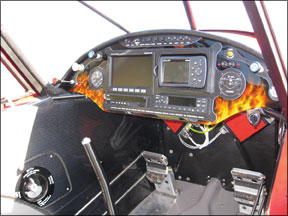
competed in a short takeoff contest.
Nineteen Super Cubs averaged 138 feet, while the Super SportCub averaged 63 feet, according to Richmond. With 80 additional horses, sub-50-foot takeoffs are probably doable.
The Cub airframe remains relatively draggy, so cruise speeds arent exceptional. Even with the higher horsepower, some of the slicker glass LSAs are faster than the SuperSport Cub. Richmond told us cruise speeds are about 110 MPH on 5 GPH and 120 MPH for a gallon more in fuel flow. With 25 gallons aboard, four-hour legs are practical.
We didnt fly the airplane long, but the seats seem comfortable enough to support that kind of flying. The seats adjust fore and aft, the rudders are easy to get to and the visibility from the front during taxiing is excellent-no need for S-turns. Solo is from the front seat only. The rear seat has a feature we really like.
By removing a bar that fits into slots, the fabric can be removed and stowed, opening up a rear cargo area large enough for a set of golf clubs and luggage. And trust us, you can land on the clubhouse lawn and taxi to a stop in front of the pro shop. The rear stick is easily removable.
Standard equipment in the LSA world seems to be the Dynon 180, with a Garmin GPSmap 496 as the main navigator and a Garmin transponder and navcomm. Surprise, thats just what the SuperSport Cub has. But Richmond says not many buyers are likely to order it that way. “My typical customer is not a digital guy-
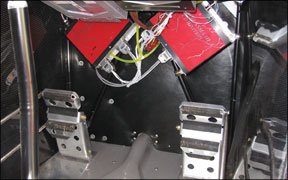
hes an analog guy,” says Richmond. The majority of buyers opt for steam-gauge panels, although with the GPSmap 496. This probably has little to do with money and more to do with age.
Cub Crafters LSA buyers are typically 20 years older than the buyer of one of the companys Super Cubs. “I could sell a dozen of these right at this show if Id take a Bonanza or a Baron in trade,” Richmond told us. Based on our assessment of the LSA market, this doesnt surprise us in the slightest. In our view, its the shape of things to come.
At a $163,285 base price for radio, intercom and composite prop, the Super SportCub pushes the price point for LSAs into the stratosphere. Fully equipped, it will be closer to $180,000. The airplane will, nonetheless, find buyers, in our view and for three reasons: one is that CubCrafters is an established company that understands its niche market.
It will never sell 100 of these a year, but it could sell 20 or 40, eventually. Second, the SuperSports short field performance so dominates the LSA field that some buyers will tilt toward it just for that, without blinking at the price. Last, the thing is just we’ll made.
CubCrafters has a history with Part 23 airplane construction and that experience is bound to rub off on the LSA. Throughout the airframe, we noticed nice little touches and attention to fit and finish details that some of the LSA manufacturers are skipping simply because they don’t have the price point to support it.
Check the detailing on the carbon fiber work in the photos. Our only worry about this airplane is the engine. It doesnt yet have an established service history in the CubCrafters iteration and although the Lycoming O-320 is bulletproof, this isn’t an O-320. CubCrafters is a standup company and were sure it will support the engine, but that doesnt mean it couldnt develop reliability snags. we’ll keep an eye on this one as the project matures.

